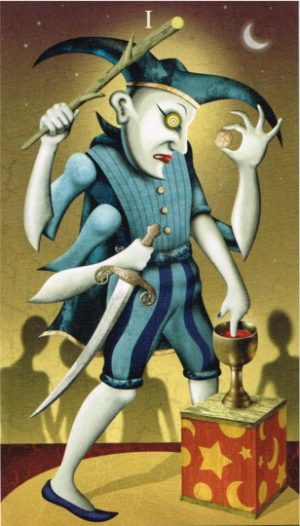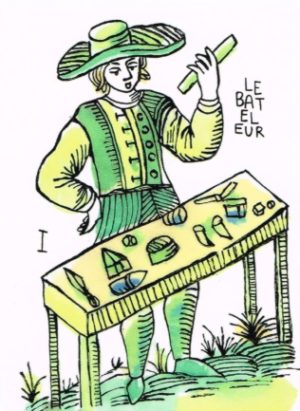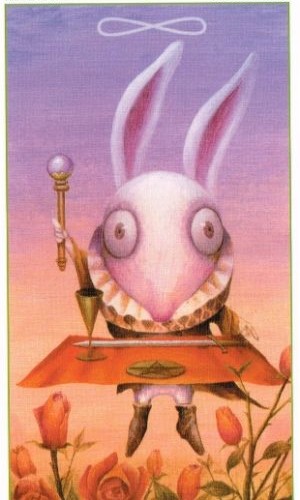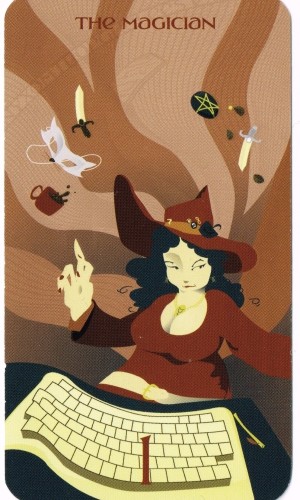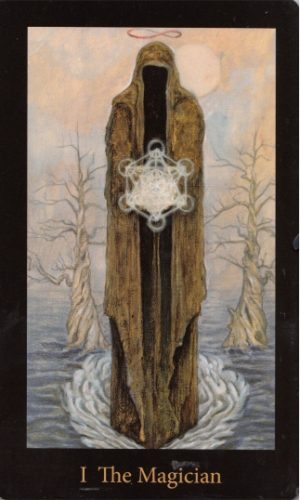The magician draws me towards him. He has power and charisma, and a generous dash of arrogance that I buy into in spite of myself. He reminds me of my history of developing unhealthy crushes on cocky, somewhat mysterious men. All of whom would probably make terrible partners, but that doesn’t stop me clinging to the fantasy.
Increasingly though, I find myself wanting to be the magician rather than lust after him. To find my own power and glamour. To create my own reality. It remains to be seen whether this is an improvement.
Who is the magician?
The Magician Is a Creator
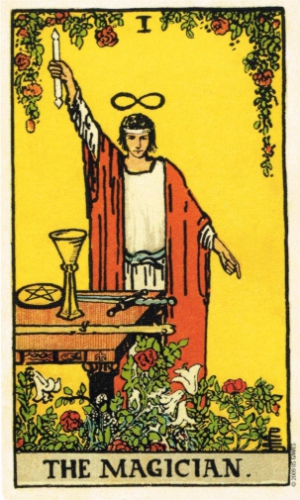
The magician personifies an active force, manifesting his desires in this reality. He possesses endless creativity. A lemniscate (infinity symbol), or hat brim curled into a similar shape, often hint at this boundlessness. The best-known Rider-Waite-Smith magician also wears an Ouroboros belt, the unending symbol of a snake eating its own tail. There is an infinite cycle of creation and destruction. The snake sheds its skin and is reborn. The magician can continually create and recreate, reinventing himself and the world.
To create something is to become god-like, in a sense. The magician can be a demiurge, from the Greek for ‘artisan’ or ‘craftsperson’. Plato described the demiurge as the father of the universe: a creator who shaped the material world. It’s an impressive design, but the demiurge didn’t create matter itself, it could only work with existing raw materials. That’s easily mistaken for the ultimate creator – the demiurge itself might even believe it – but this is short-sighted.
- What is being created?
- What is being destroyed?
The Magician is a Messenger

The magician is often associated with Mercury (or Hermes, in Greek mythology). Or alternatively, with the figure of Hermes Trismegistus, who is probably a blend of the Greek Hermes and Egyptian Thoth, both gods of magic and communication.
Communication takes ideas from the realm of pure thought and turns them into something more tangible we can share and work with. This is always an imperfect process. The thought we have is never identical to the idea we transmit to someone else. The artist can never fully express their inspiration. And so, even a well-intentioned magician blends wisdom with lies.
In the Thoth tarot, the Ape of Thoth sits by the magus’ left foot. He mocks and distorts all communication. Manifestation always involves illusion. The magus has the courage to persist and find wisdom even in his imperfection.
- What needs to be communicated?
- What is being misunderstood?
- What are you afraid to speak or create?
The Magician Is a Trickster
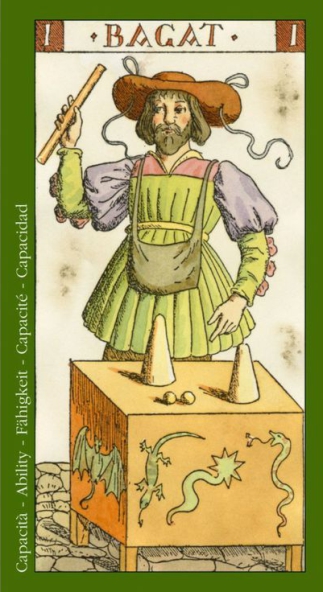
As well as being the messenger of the gods, Hermes likes to fool people, and is the patron god of thieves. A fairground magician might entertain you, or he might try to swindle you. Like the classic cup and shell game, the outcome is rigged against you. The magician is skilled and intelligent, but not always ethical. He might con you, or over-sell his abilities.
By breaking the rules, the magician can act as a warning about those who would deceive you. He might also be a revolutionary force, pushing against rules that deserve to be challenged.
- What do you lie about, and why?
- Is someone else being dishonest?
- Do you enjoy trickster characters in stories? How does this play out in life?
The Magician Is a Nexus
The magician stands between worlds. Perhaps he bars the way, demanding a token or ritual before he will bless your passage. Or maybe the magician is more guide than barrier, like Hermes transporting souls to the underworld. Is the magician inviting you through the gate, showing the the path to some new dimension or state of consciousness? Gatesways are important. The pivotal turning points between one state and other. A journey to another place, a transmutation, or a transmission of information.
The street magician specialises in transforming the everyday into the fantastic. During a performance he becomes someone important, if only for a moment. His fancy clothes and clever tricks can captivate all kinds of people. It’s a reminder that ideas are powerful. On some level, thought creates reality. The performer can become ‘real’ to us as part of the act.
- What is changing?
- Where are you going?
- What barriers are in the way?
- What helps and guides us?
The Magician Is a Novice
The magician sits at number one in a sequence: a beginning or a conception of something. Often, he’s a youthful figure. A kind of eternal teenager. Immensely talented perhaps, but still immature. He’s a newly developed identity, fiercely individualistic and probably somewhat egotistical.
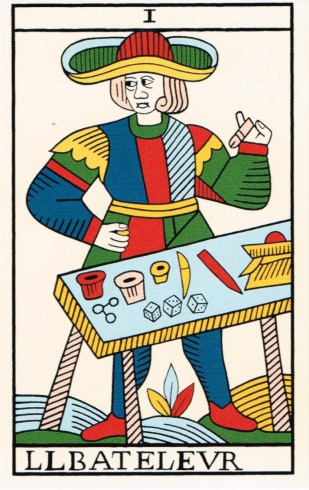
The magician is a newly developed sexuality. That can be potent, but also confusing. In Marseille-style decks the magician’s table often cuts across the card, obscuring the magician’s pelvis and suggesting possible sexual or creative blocks. Above the table he must project confidence. Below the table his feet point in different directions. Is he uncertain or unstable?
Between the magician’s legs, you might notice a plant forming the shape of a woman’s pelvis, hinting at the magician’s origin. Or maybe his desires. Does he embrace his own sexuality or does he shy away? Maybe he’s still finding himself, or struggling with what’s expected of him. Does he want to leave repressive ideas behind?
The Magician Uses Tools
The magician’s table holds the four tarot suits or elements, suggesting the basic components of existence. Often, a dove will also hint at the fifth element of spirit or æther, such as in an etching on the side of the table. The Marseille-style magician often has a range of assorted tools of the trade, including pair of dice he might use for both gambling and divination.
In the Thoth tarot, the Magus juggles a range of tools (or weapons), comprising elements of the universe, as well as tools of communication and power. A winged egg is an embryonic form of the ancient Greek “orphic egg”: a form of cosmic potential here suggesting intuition and spirit. Horus’ Wand of Double Power allows the magician to unite opposite forces. He creates a link between form and formlessness.
In some versions of the magician card, the elements appear to sit passively by, while in other cases they are being used for some trick or spell. Regardless, all these tools are easily to hand and the magician knows how to use them.
The most fundamental tool is the magician’s own body. He typically points his wand to the sky and other hand to earth, a gesture that forms a conduit between spirit and earth. He embodies the popular hermetic philosophy “as above, so below”. Meaning all planes of existence are connected and reflect one another. Human existence can be a microcosm of the universe.
Exercise: which tools does this magician prefer?
It can be fun to compare elements or tools between tarot decks. While some magicians have a balanced energy, others lean primarily in a particular direction. Maybe a magician combines elements in clever ways.
- Which versions of the magician do you resonate with, and why?
- Do you find this changing over time?
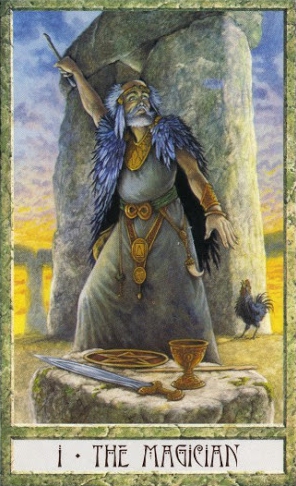
The Magician Is a Tradesperson
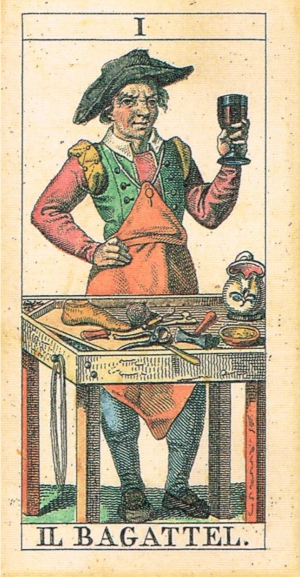
Back at ground level, there’s another take on the magician’s use of tools. In some (mostly Italian) decks, he is not a powerful mage, nor even an entertainer, but simply a mundane tradesperson. Most commonly a shoemaker.
We can’t know the full reasoning behind the origin of the cobbler-magician, though either translation or wordplay play a part. In Milanese dialect, the word for cobber is similar to the word for juggler (as the magician is sometimes known). Whatever the historical truth beyond this, any stories we tell become part of the symbol, which informs some facet of how we might think of the magician.
People have come up with many different explanations for the shoemaker. To some, he’s an example of tarot’s hidden mystical knowledge. A workman’s apron becomes Masonic ceremonial garb, while a glass of wine is the holy grail. Shoes and shoemakers also appear in many fairytales, which hold their own lessons and ideas.
Both the street magician and the cobbler are independent artisans. They carve out their own version of attention or wealth, without the social status that might be expected from a card sitting alongside royalty and religious leaders. The magician can be seen as a disruption to an old-fashioned social order.
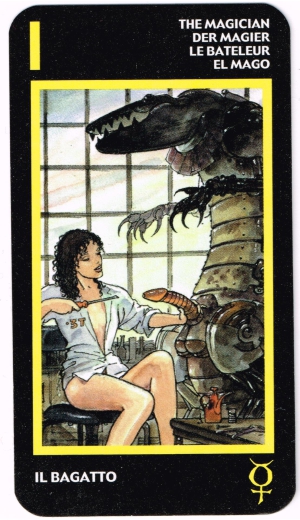
The tradesperson-magician can take interesting forms. For something completely different… in the Manara Erotic tarot the magician is a tinkerer working on her robot sex dinosaur.
This might be a silly example, but it’s also a perfect subversion of what is considered proper and socially acceptable.
- The development of tarot takes the magician from humble origins as a performer, a swindler or a tradesperson, and over time transforms him into a symbol of power and wisdom. Are there any common threads between all these versions of the magician?
- In what ways does the magician contradict himself? Can it be reconciled?
My approach to understanding tarot involves collecting ideas from many different decks, books and other sources, mixed with my own impressions. This necessarily remains incomplete and subjective. As always, take anything you can use and leave the rest.

